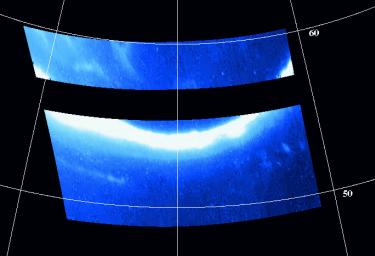Auroral emissions are created when fast moving charged particles from the region around Jupiter strike the atoms and molecules of Jupiter's upper atmosphere. Such emission tends to be concentrated within two large ovals, one surrounding each magnetic pole. Although Jupiter's auroral ovals have been imaged before at far-ultraviolet and far-infrared wavelengths, this is the first image of a Jovian auroral oval taken at visible/near-infrared wavelengths (roughly 400 to 1100 nanometers).
In particular, this image shows the equator most part of the northern auroral oval on Jupiter's nightside. The raw image has been map projected onto a grid of west longitudes and planetocentric latitudes, with north at the top. False color has been added to show the most intense emission as white.
Although several rows of data are missing, one can see that: (i) in this wavelength range the northern oval is prominent and very intense; (ii) there are patchy auroral emissions both above and below the main oval; (iii) those patchy emissions tend to be brighter above the oval than below it. In all these regards this image is similar to images of the Jovian aurora taken at ultraviolet wavelengths, and to images of the Earth's aurora taken from space. The latter similarity is especially remarkable, given the large differences between Earth and Jupiter in their charged particle and magnetic environments.
This image was taken at 6 hours 57 minutes Universal Time on Nov. 9, 1996 through the clear filter of the solid state imaging (CCD) system aboard NASA's Galileo spacecraft. Galileo was then in Jupiter's shadow, and located about 2.3 million kilometers (about 32.5 Jovian radii) from the planet. The smallest discernible features in this image are about 45 kilometers across.
The Jet Propulsion Laboratory, Pasadena, CA manages the mission for NASA's Office of Space Science, Washington, DC.
This image and other images and data received from Galileo are posted on the World Wide Web, on the Galileo mission home page at URL http://galileo.jpl.nasa.gov.

 Planetary Data System
Planetary Data System












